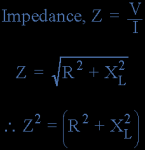mbrooke
Batteries Included
- Location
- United States
- Occupation
- Technician
What is the proper way to calculate total circuit impedance? Do I obtain the Z of each wire segment then add all the Zs together or do I add up all the Rs and Xs for the total system and then do the math to obtain Z? Which way is right and which way is wrong and why would it matter?


Total Z= 0.07433+0.49265+2.00073= 2.56771 ohms
OR
R= 0.062+0.49+2.0=2.552
X= 0.041+0.051+0.054=0.146
Z= 2.55617


Total Z= 0.07433+0.49265+2.00073= 2.56771 ohms
OR
R= 0.062+0.49+2.0=2.552
X= 0.041+0.051+0.054=0.146
Z= 2.55617

